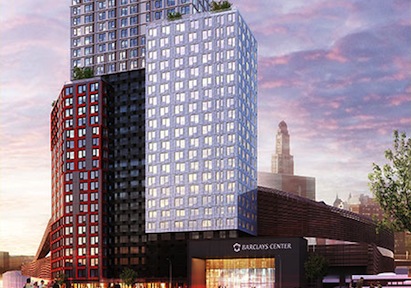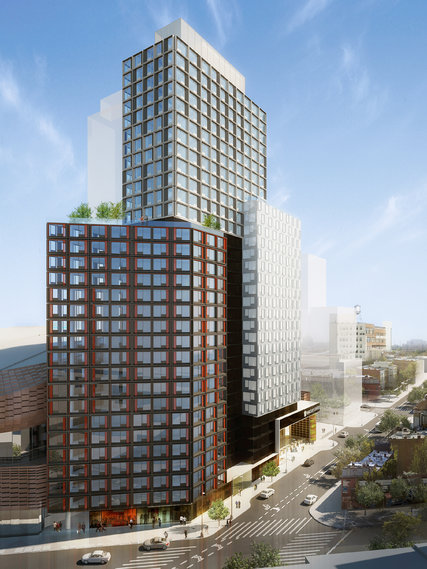At 32 stories, the B2 residential tower at Atlantic Yards near Brooklyn has been widely lauded as a bellwether for modular construction. But since construction started about 18 months ago, only five of the floors have been built—and developer Forest City Ratner Companies now has a Chinese partner that will move forward on the next three residential buildings, using conventional construction.
According to a report in the New York Times, Forest City Ratner's development partner, Greenland Holding Group, will now have a majority stake in the 22-acre Atlantic Yards mixed-use project. The Shanghai-based firm will oversee the next three residential tower projects, while Forest City Ratner continues to move forward with B2. Completion of the 348,000-sf modular tower, comprising 930 modules and 363 apartments, had been moved to late 2015, more than a year later than planned.
MaryAnne Gilmartin, Forest City Ratner's chief executive, says technical difficulties have been substantial, both at the nearby factory that's creating the modules and on the Atlantic Yards job site. “It’s been terribly frustrating," she told the New York Times. "But I don’t think this is a referendum on modular. The best way to prove that this works is to build B2.”
The Building Team for B2 includes Skanska, FC + Skanska Modular (a collaboration between Forest City Ratner and Skanska, which is building the components), SHoP, and Arup.
Related Stories
| Oct 5, 2011
GREENBUILD 2011: Brick offers growing options for sustainable building design
Brick exteriors, interiors and landscaping options can increase sustainability that also helps earn LEED certification.
| Oct 5, 2011
GREENBUILD 2011: Roof hatch designed for energy efficiency
The cover features a specially designed EPDM finger-type gasket that ensures a positive seal with the curb to reduce air permeability and ensure energy performance.
| Oct 4, 2011
GREENBUILD 2011
Click here for the latest news and products from Greenbuild 2011, Oct. 4-7, in Toronto.
| Oct 4, 2011
GREENBUILD 2011: Methods, impacts, and opportunities in the concrete building life cycle
Researchers at the Massachusetts Institute of Technology’s (MIT) Concrete Sustainability Hub conducted a life-cycle assessment (LCA) study to evaluate and improve the environmental impact and study how the “dual use” aspect of concrete.
| Oct 4, 2011
GREENBUILD 2011: Johnsonite features sustainable products
Products include rubber flooring tiles, treads, wall bases, and more.
| Oct 4, 2011
GREENBUILD 2011: Nearly seamless highly insulated glass curtain-wall system introduced
Low insulation value reflects value of entire curtain-wall system.
| Oct 4, 2011
GREENBUILD 2011: Ready-to-use wood primer unveiled
Maintains strong UV protection, clarity even with application of lighter, natural wood tones.
| Oct 4, 2011
GREENBUILD 2011: Two new recycled glass products announced
The two collections offer both larger and smaller particulates.
| Oct 4, 2011
GREENBUILD 2011: Mythic Paint launches two new paint products
A high performance paint, and a combination paint and primer now available.

















